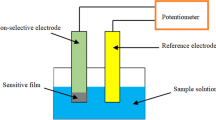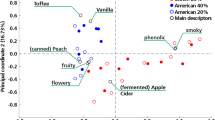Abstract
A novel fingerprinting platform for multiplex detection of flavor molecules in Baijiu was developed by using a surface-enhanced Raman scattering (SERS) nanosensor array in combination with machine learning. The SERS sensors were constructed by core–shell Fe3O4@Ag nanoparticles modified with molecules carrying end-groups of hydroxyl, pyridyl, methyl, and amino, respectively, which interacted with flavors and led to changes in the sensors’ spectra. All the Raman spectra acquired from the nanosensor array contacting with the sample were concatenated into a single SERS super-spectrum, representing the flavor fingerprint which was recognized through machine learning. Principal component analysis, support vector machine, and partial least squares were utilized to build classification and quantitation models for predictive analyses. The SERS nanosensor array was successfully used for fingerprinting ten typical flavors in Baijiu including four esters, three alcohols, and three acids, with an accuracy of 100%, linear detection ranges over two orders of magnitude, and limits of detection ranging from 3.45 × 10−3 mg/L of phenylethyl acetate to 1.21 × 10−2 mg/L of ethyl hexanoate. It was also demonstrated that satisfactory accuracies (recoveries) ranging from 96.2 to 104% and relative standard deviations ranging from 0.65 to 2.78% were obtained for the simultaneous quantification of 3-methylbutyl acetate and phenylethyl acetate in eighteen Baijiu samples of three flavor types including sauce flavor, strong flavor, and light flavor. Compared with the existing detection techniques, this chemical fingerprinting platform is easy to use, highly sensitive, and can perform multiplex detection, which has great potential for practical applications.
Graphical abstract







Similar content being viewed by others
Data Availability
We confirm that the data supporting the findings of this study are available within the article and its supplementary materials.
References
Zheng XW, Han BZ (2016) Baijiu (白酒), Chinese liquor: history, classification and manufacture. J Ethnic Foods 3:19–25. https://doi.org/10.1016/j.jef.2016.03.001
Wei Y, Zou W, Shen CH (2020) Basic flavor types and component characteristics of Chinese traditional liquors: a review. J Food Sci 85:4096–4107. https://doi.org/10.1111/1750-3841.15536
Jia W, Fan Z, Du A et al (2020) Recent advances in Baijiu analysis by chromatography based technology–a review. Food Chem 324:126899. https://doi.org/10.1016/j.foodchem.2020.126899
Cuadros-Rodríguez L, Ruiz-Samblás C, Valverde-Som L et al (2016) Chromatographic fingerprinting: an innovative approach for food ‘identitation’ and food authentication–a tutorial. Anal Chim Acta 909:9–23. https://doi.org/10.1016/j.aca.2015.12.042
Fitzgerald JE, Bui ETH, Simon NM et al (2017) Artificial nose technology: status and prospects in diagnostics. Trends Biotechnol 35:33–42. https://doi.org/10.1016/j.tibtech.2016.08.005
Umali AP, Anslyn EV (2010) A general approach to differential sensing using synthetic molecular receptors. Curr Opin Chem Biol 14:685–692. https://doi.org/10.1016/j.cbpa.2010.07.022
Geng Y, Peveler WJ, Rotello VM (2019) Array-based “chemical nose” sensing in diagnostics and drug discovery. Angew Chem Int Ed 58:5190–5200. https://doi.org/10.1002/anie.201809607
Li Z, Suslick KS (2020) The optoelectronic nose. Accounts Chem Res 54:950–960. https://doi.org/10.1021/acs.accounts.0c00671
Han J, Chao M, Wang B et al (2017) A hypothesis-free sensor array discriminates Whiskies for brand, age, and taste. Chem 2:817–824. https://doi.org/10.1016/j.chempr.2017.04.008
Wu M, Chen H, Fan Y et al (2022) Carbonyl flavor compound-targeted colorimetric sensor array based on silver nitrate and o-phenylenediamine derivatives for the discrimination of Chinese Baijiu. Food Chem 372:131216. https://doi.org/10.1016/j.foodchem.2021.131216
Li J, Liu X, Luo H et al (2022) A gold nanorods etching based colorimetric sensor array for the detection of reducing substances and discrimination of Chinese baijiu. Food Anal Methods 15:2605–2614. https://doi.org/10.1007/s12161-022-02269-4
Jia J, Wu M, Wang S et al (2020) Colorimetric sensor array based on silver deposition of gold nanorods for discrimination of Chinese white spirits. Sens Actuat B: Chem 320:128256. https://doi.org/10.1016/j.snb.2020.128256
Chen Y, Wang S, Hu Y et al (2021) Novel colorimetric sensor array for identification of baijiu using color reactions of flavor compounds. Microchem J 167:106277. https://doi.org/10.1016/j.microc.2021.106277
Xu J, Yuan H, Zhou H et al (2023) A novel fluorescent sensor array to identify Baijiu based on the single gold nanocluster probe. Spectrochim Acta A: Mol Biomol Spectrosc 284:121787. https://doi.org/10.1016/j.saa.2022.121787
Dai H, Jia J, Fan Y et al (2021) Four-channel fluorescent sensor array based on various functionalized CdTe quantum dots for the discrimination of Chinese baijiu. Spectrochim Acta A: Mol Biomol Spectrosc 252:119513. https://doi.org/10.1016/j.saa.2021.119513
Li J, Shui Z, Dong L et al (2020) A novel acid-sensitive quantum dot sensor array for the identification of Chinese baijiu. Anal Methods 12:4789–4797. https://doi.org/10.1039/D0AY01454K
Li A, Jia J, Fan Y et al (2021) Furfural and organic acid targeted carbon dot sensor array for the accurate identification of Chinese baijiu. J Food Sci 86:2924–2938. https://doi.org/10.1111/1750-3841.15766
Leong YX, Lee YH, Koh CSL et al (2021) Surface-enhanced Raman scattering (SERS) taster: a machine-learning- driven multireceptor platform for multiplex profiling of wine flavors. Nano Lett 21:2642–2649. https://doi.org/10.1021/acs.nanolett.1c00416
Langer J, de Aberasturi DJ, Aizpurua J et al (2020) Present and future of surface-enhanced raman scattering. ACS Nano 14:28–117. https://doi.org/10.1021/acsnano.9b04224
Jiang L, Hassan MM, Ali S et al (2021) Evolving trends in SERS-based techniques for food quality and safety: a review. Trends Food Sci Technol 112:225–240. https://doi.org/10.1016/j.tifs.2021.04.006
Cho SH, Baek KM, Han HJ et al (2020) Selective, quantitative, and multiplexed surface-enhanced Raman spectroscopy using aptamer-functionalized monolithic plasmonic nanogrids derived from cross-point nano- welding. Adv Funct Mater 30:2000612. https://doi.org/10.1002/adfm.202000612
Kim N, Thomas MR, Bergholt MS et al (2020) Surface enhanced Raman scattering artificial nose for high dimensionality fingerprinting. Nat Commun 11:1–12. https://doi.org/10.1038/s41467-019-13615-2
Zhu S, Fan C, Wang J et al (2015) Realization of high sensitive SERS substrates with one-pot fabrication of Ag–Fe3O4 nanocomposites. J Colloid Interf Sci 438:116–121. https://doi.org/10.1016/j.jcis.2014.09.015
Gong P, Li H, He X et al (2007) Preparation and antibacterial activity of Fe3O4@Ag nanoparticles. Nanotechnology 18:285604. https://doi.org/10.1088/0957-4484/18/28/285604
Li R, Ji W, Chen L et al (2014) Vibrational spectroscopy and density functional theory study of 4-mercaptophenol. Spectrochim Acta A: Mol Biomol Spectrosc 122:698–703. https://doi.org/10.1016/j.saa.2013.11.109
Zhang X, Sui H, Wang X et al (2016) Charge transfer process at the Ag/MPH/TiO2 interface by SERS: alignment of the Fermi level. Phys Chem Chem Phys 18:30053–30060. https://doi.org/10.1039/C6CP04370D
Hu J, Zhao B, Xu W et al (2002) Surface-enhanced Raman spectroscopy study on the structure changes of 4-mercaptopyridine adsorbed on silver substrates and silver colloids. Spectrochim Acta A: Mol Biomol Spectrosc 58:2827–2834. https://doi.org/10.1016/S1386-1425(02)00074-4
Ligorio RF, Krawczuk A, Dos Santos LHR (2020) Crystal field effects on atomic and functional-group distributed polarizabilities of molecular materials. J Phys Chem A 124:10008–10018. https://doi.org/10.1021/acs.jpca.0c09293
Wang Y, Yu Z, Ji W et al (2014) Enantioselective discrimination of alcohols by hydrogen bonding: a SERS study. Angew Chem Int Edit 126:14086–14090. https://doi.org/10.1002/ange.201407642
Némethy G (1967) Hydrophobic interactions. Angew Chem Int Ed 6:195–206. https://doi.org/10.1002/anie.196701951
Haynes WM, Lide DR, Bruno TJ (2016) CRC handbook of chemistry and physics, 97th ed. CRC Press, Boca Raton. https://doi.org/10.1201/9781315380476
Zhang H, Lai H, Li G et al (2020) 4-Aminothiophenol capped halloysite nanotubes/silver nanoparticles as surface- enhanced Raman scattering probe for in-situ derivatization and selective determination of nitrite ions in meat product. Talanta 220:121366. https://doi.org/10.1016/j.talanta.2020.121366
Xu P, Kang L, Mack NH et al (2013) Mechanistic understanding of surface plasmon assisted catalysis on a single particle: cyclic redox of 4-aminothiophenol. Sci Rep 3:1–6. https://doi.org/10.1038/srep02997
Liu Y, Yang D, Zhao Y et al (2019) Solvent-controlled plasmon-assisted surface catalysis reaction of 4-aminothio- phenol dimerizing to p, p’-dimercaptoazobenzene on Ag nanoparticles. Heliyon 5:e01545. https://doi.org/10.1016/j.heliyon.2019.e01545
Lim JY, Nam JS, Shin H et al (2019) Identification of newly emerging influenza viruses by detecting the virally infected cells based on surface enhanced Raman spectroscopy and principal component analysis. Anal Chem 91:5677–5684. https://doi.org/10.1021/acs.analchem.8b05533
Lussier F, Thibault V, Charron B et al (2020) Deep learning and artificial intelligence methods for Raman and surface-enhanced Raman scattering. TrAC Trends Anal Chem 124:115796. https://doi.org/10.1016/j.trac.2019.115796
Wold S, Sjöström M, Eriksson L (2001) PLS-regression: a basic tool of chemometrics. Chemom Intell Lab 58:109–130. https://doi.org/10.1016/S0169-7439(01)00155-1
Farifteh J, Van der Meer F, Atzberger C et al (2007) Quantitative analysis of salt-affected soil reflectance spectra: a comparison of two adaptive methods (PLSR and ANN). Remote Sens Environ 110:59–78. https://doi.org/10.1016/j.rse.2007.02.005
Cheng JH, Sun DW (2017) Partial least squares regression (PLSR) applied to NIR and HSI spectral data modeling to predict chemical properties of fish muscle. Food Eng Rev 9:36–49. https://doi.org/10.1007/s12393-016-9147-1
Funding
This study was supported by grants from the National Natural Science Foundation of China (31770113, 22074009) and the Chongqing Chongqing Natural Science Foundation (CSTB2022NSCQ--MSX1373).
Author information
Authors and Affiliations
Contributions
XLW: conceptualization, funding acquisition, and writing; LJ: methodology, investigation, and writing; QLS: investigation and software; ZHM: conceptualization, funding acquisition, supervision, and validation.
Corresponding authors
Ethics declarations
Competing interests
The authors declare no competing interests.
Additional information
Publisher's note
Springer Nature remains neutral with regard to jurisdictional claims in published maps and institutional affiliations.
Supplementary information
Below is the link to the electronic supplementary material.
Rights and permissions
Springer Nature or its licensor (e.g. a society or other partner) holds exclusive rights to this article under a publishing agreement with the author(s) or other rightsholder(s); author self-archiving of the accepted manuscript version of this article is solely governed by the terms of such publishing agreement and applicable law.
About this article
Cite this article
Wei, XL., Jiang, L., Shi, QL. et al. Machine-learning-assisted SERS nanosensor platform toward chemical fingerprinting of Baijiu flavors. Microchim Acta 190, 207 (2023). https://doi.org/10.1007/s00604-023-05794-z
Received:
Accepted:
Published:
DOI: https://doi.org/10.1007/s00604-023-05794-z




